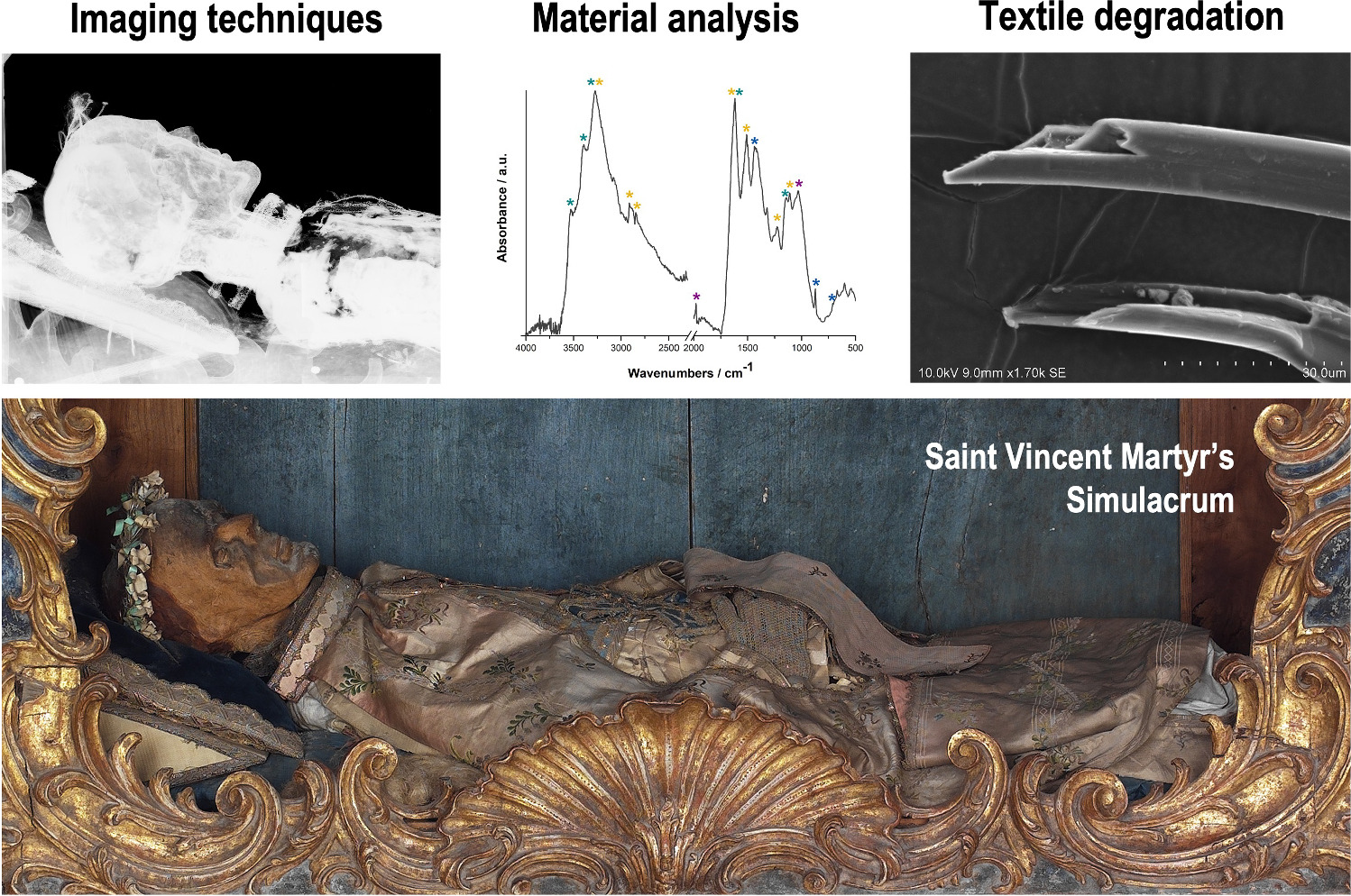https://doi.org/10.1140/epjp/s13360-025-06405-x
Regular Article
Exploring a forgotten heritage: the case study of Saint Vincent Martyr's simulacrum
1
School of Arts, Research Center for the Science and Technology of the Arts (CITAR), Universidade Católica Portuguesa, Rua de Diogo Botelho 1327, 4169-005, Porto, Portugal
2
HERCULES Laboratory/ IN2PAST, Associate Laboratory for Research and Innovation in Heritage, Arts, Sustainability and Territory, University of Évora, Largo Marquês de Marialva 8, Évora, Portugal
3
Laboratório José de Figueiredo, Museus e Monumentos de Portugal, Rua das Janelas Verdes, 1249-018, Lisbon, Portugal
4
University of Évora, Chemistry and Biochemistry Department, ECT, Rua Romão Ramalho 59, Évora, Portugal
a
jcpalmeirao@gmail.com
b
tasf@uevora.pt
Received:
15
November
2024
Accepted:
6
May
2025
Published online:
4
June
2025
The simulacrum of Saint Vincent Martyr, one of four corpi santi at the Major Seminary of Coimbra, Portugal, features Roman-origin bones mounted in metallic frameworks and covered with intricate Baroque garments. Enshrined within the urn-altar in Saint Michael's Chapel, its remains were exhumed from the Catacomb of Priscila and brought to Portugal in 1760 by Bishop Count D. Miguel da Anunciação. This study employs a multianalytical approach to examine the simulacrum's materiality, construction, and state of conservation. Non-invasive techniques, including digital radiography and borescope inspection, assessed structural integrity and skeletal arrangement. When feasible, micro-samples were collected for laboratory analysis. Optical microscopy and scanning electron microscopy with chemical analysis were used to analyse paper, textile fibres, and metal threads, revealing evidence of both craftsmanship and deterioration patterns. Additionally, Fourier-transform infrared spectroscopy characterised adhesives, coatings, and pigments, while chromatographic techniques identified dyes in garments and wax components on the face. Results corroborated photochemical damage, textile decay, and structural alterations, with in situ radiographic analyses revealing misaligned skeletal remains. Notably, softwood pulp paper with kaolin and an emerald green pigment in the flower crown points to a 19th-century local intervention after the French invasions of 1810. Furthermore, calcium carbonate in wax and lead-based pigments with iron oxides on the simulacrum's face indicate intentional methods to enhance durability and mimic human features. This study integrates material analysis with historical context to deepen understanding of Saint Vincent's simulacrum, tracing its material transformations and informing future conservation strategies for similar artefacts.
Supplementary Information The online version contains supplementary material available at https://doi.org/10.1140/epjp/s13360-025-06405-x.
© The Author(s) 2025
 Open Access This article is licensed under a Creative Commons Attribution 4.0 International License, which permits use, sharing, adaptation, distribution and reproduction in any medium or format, as long as you give appropriate credit to the original author(s) and the source, provide a link to the Creative Commons licence, and indicate if changes were made. The images or other third party material in this article are included in the article's Creative Commons licence, unless indicated otherwise in a credit line to the material. If material is not included in the article's Creative Commons licence and your intended use is not permitted by statutory regulation or exceeds the permitted use, you will need to obtain permission directly from the copyright holder. To view a copy of this licence, visit http://creativecommons.org/licenses/by/4.0/.
Open Access This article is licensed under a Creative Commons Attribution 4.0 International License, which permits use, sharing, adaptation, distribution and reproduction in any medium or format, as long as you give appropriate credit to the original author(s) and the source, provide a link to the Creative Commons licence, and indicate if changes were made. The images or other third party material in this article are included in the article's Creative Commons licence, unless indicated otherwise in a credit line to the material. If material is not included in the article's Creative Commons licence and your intended use is not permitted by statutory regulation or exceeds the permitted use, you will need to obtain permission directly from the copyright holder. To view a copy of this licence, visit http://creativecommons.org/licenses/by/4.0/.





